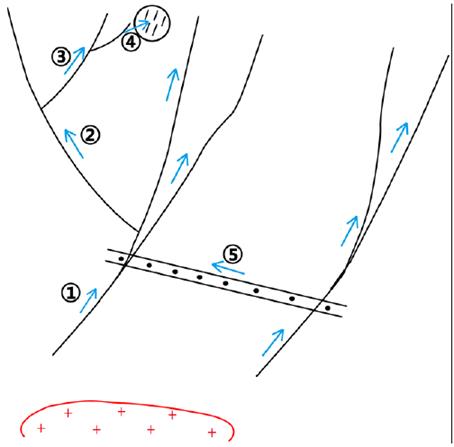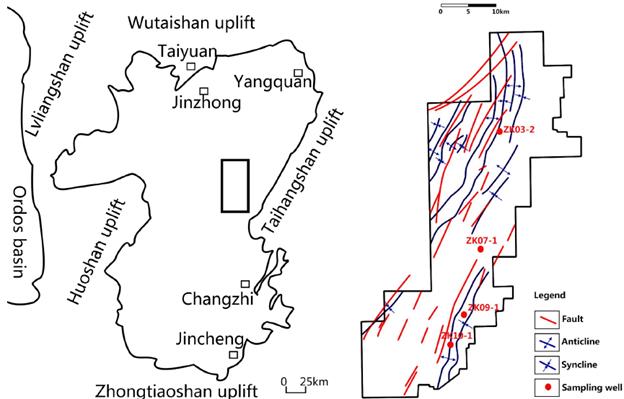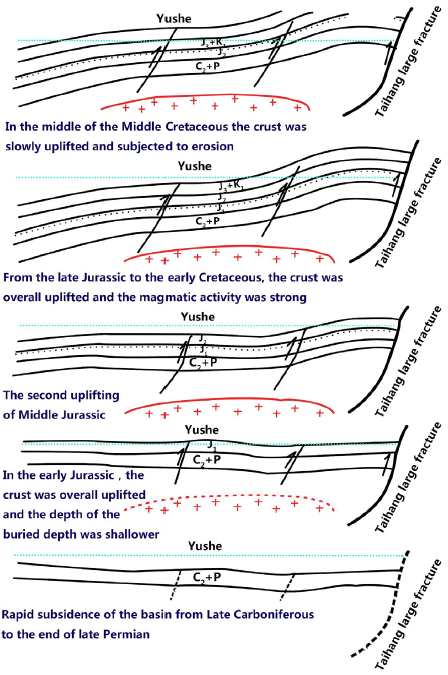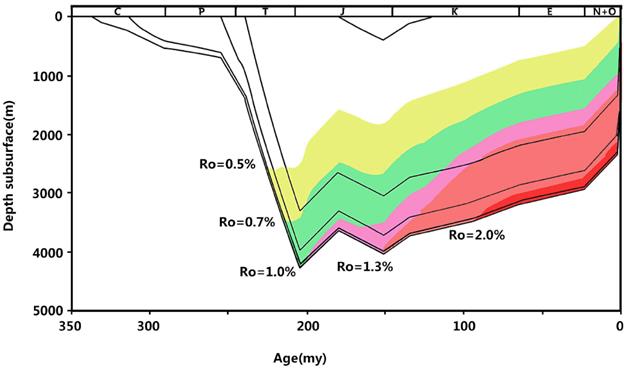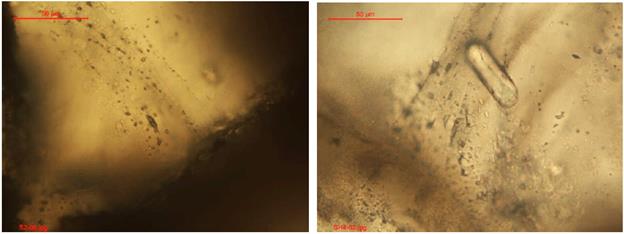Introduction
For a long time, scholars at home and abroad generally believe that the magmatic and volcanic activities of oil-bearing basins depict a considerable influence on the generation, migration, and accumulation of oil and gas. However, it is only during the previous decade or so that some scholars have paid attention to this phenomenon.
Magma can invade the sedimentary formations in sedimentary basins in the form of dikes or caprocks and can heat the rocks that are located within a certain distance from the dikes (Zhang, Guan, & Jian, 2014; Li et al., 2016). If the sedimentary (argillaceous) shales are abundant in organic matter, they will accelerate the maturation of the source rock formations (Rodriguez, Villar, & Baudino, 2007; Polteau, el at., 2016; Peace el at., 2017; Alalade & Tyson, 2013; Hakimi et al., 2017). If magma invades in the form of dikes, either underneath or on both the sides of the dikes, there may be different heat conduction conditions that are caused due to the different heating effects; consequently, the source rocks will exhibit different maturity and heating ranges (Zhu, Jin, Hu, Song, & Gao, 2007). The distance from the source rocks to the dikes is also an important factor that affects their maturity. Due to the different heating effects, halos with different degrees of maturity can be formed around the dikes (Muirhead, Bowden, Parnell & Schofield, 2017). Under special conditions, even asphalt veins that are parallel to the dikes will be formed (Zanella, Cobbold, Ruffet, & Leanza, 2015). In the Atlantic research drilling project, it was observed that the intrusion of dikes significantly affects the maturity of the organic matter. Magmatic intrusions and volcanism affect the thermal history of the sedimentary basins and the maturation history of the source rocks (Spacapan et al., 2018). The magmatic intrusion thickness, duration of intrusion, and distance from the rock mass affects the hydrocarbon generation (Aarnes, Planke, Trulsvik, & Svensen, 2015). In addition, Polyansky, Reverdatto, Khomenko & Kuznetsovab (2009) postulated that the flow of the formation water is an auxiliary heat transfer method.
Several scholars have used various modeling methods to simulate magmatic intrusion and hydrocarbon generation after heating the source rocks (Sydnes, Fjeldskaar, Letveit, Grunnaleite, & Cardozo, 2018; Iyer, Svensen, & Schmid, 2018). Guangwen et al. conducted numerical thermal simulation studies on the heat dissipation process of invasive magma and classified the evolution of the source rocks into three modes: near, middle, and far (Tian, Jiang, Pang, Meng, & Fu, 2005).
Several scholars have observed methane gas emissions while studying magmatic and volcanic activities (Iyer, Schmid, Planke, & Millett, 2017; Frieling et al., 2016). Evidence not only proves that magmatic and volcanic activities are conducive to generate hydrocarbons, such as light hydrocarbons and methane, but also proves that the generation of H2S in certain oil and gas fields is closely related with the magmatic intrusions (Alberdi-Genolet, Cavallaro, Hernandez, Crosta, & Martinez, 2013).
The "magmatic thermal field" that is formed by magmatic activities not only heats the source rocks and promotes hydrocarbon generation but also exhibits a certain transformation effect on reservoirs (Zhang, Jin, Li, & Jiao, 2014; Zhang et al., 2016; Senger, Planke, Polteau, Ogata, & Svensen, 2014); magmatic and volcanic activities may also play a positive role in the migrations of oil and gas and the formation of hydrocarbon traps (Rateau, Schofield, & Smith, 2013; Cukur et al., 2010; Xu, Fang, Zhang, Hu, & Zhu, 2006). The magmatic ascending channels of magmatic and volcanic activities can later become hydrocarbon migration channels (Schofield et al., 2017) the magmatic intrusion into salt rock formations can form hydrocarbon migration channels (Blazic & Moreau, 2016); and a magmatic intrusion can form hydrocarbon storage spaces (Witte, Bonora, Carbone, & Oncken, 2012). The intrusion of caprocks deforms the strata and forms a trap structure that is similar to that of salt rock diapirism. After weathering the volcanic structure, it can also form a storage space that can be used as both oil and gas reservoirs (Lee, Kwon, Yoon, Kim, & Yoo, 2006). Additionally, magmatic activities exhibit a destructive effect on the existing reservoirs and can damage pores as well as fracture systems (Salmachi, Rajabi, Reynolds, Yarmohammadtooski, Wainman, 2016; Gao & Liu, 2003).
Previous researches about the effect of magmatic activities on hydrocarbon accumulation mainly focused on the mass of a rock or the effect of the volcano itself on hydrocarbon generation in source rocks as well as hydrocarbon migration and accumulation. This study intends to use the metal-non-metal mineral gas-water hydrothermal concept to deeply analyze and study the movement of magmatic heating water that was formed in magmatic activities in the eastern Qinshui Basin and the effect of the formed magmatic thermal field on hydrocarbon accumulation, which can give rise to new ideas and methods concerning hydrocarbon accumulation due to magmatic activities.
Movement of magmatic heating water in the formation and the formed magma thermal field
In ore-deposit, hydrothermal gas-water rises along a certain channel after being heated by magmatic rocks. Mineralization is observed at the appropriate formational sites with surrounding rocks, which forms useful metal and non-metallic deposits. Inspired by this concept, the authors of this study believe that the hydrothermal gas-water heated by magma depicts a positive effect on hydrocarbon accumulation.
The movement channel of magmatic heating water
After the emplacement of magma, because the temperature of magma is as high as 800°C to 1300°C, the water in the surrounding formation is heated by magma to form magmatic heating water. The magmatic heating water flows in the strata and it not only carries the ore-forming material that can form ore deposits but also carries a large amount of heat in the strata that is located far from the magmatic emplacement location. When the water is heated, the physical properties are observed to alter. The most significant change is the increase in volume and the decrease in density; the water with less density will move through the appropriate channels to the shallow parts of the stratum under the action of buoyancy.
At the macro level, various fracture systems developed in the basin include large-scale fractures and faults; at the micro level, the various cracks and microfissures that are observed to develop in the formation rocks are good magmatic heating water movement channels. Additionally, all kinds of rock and debris particles will expand and become brittle when the temperature increases. It is easier to form tensile or extrusion cracks under the influence of structural movement stress and to improve the thermal water passing capacity of micro cracks and micro cracks.
Micro-level cracks and microfissures are extensively distributed in the strata, and their effects on thermal water movement cannot be ignored. The imbibition is a phenomenon of surface action that occurs when two media are in contact with each other. Under normal circumstances, all the rocks in the formation are mostly characterized by water wetting and strong hydrophilia. Therefore, magmatic heating water will enter the fracture along the walls of cracks or microfissures through the action of imbibition, thereby heating the formation and increasing the temperature of the formation. This is beneficial to improve the organic matter maturity in source rocks.
In addition to fractures, faults, cracks, and microfissures of various sizes, the unconformity between formations and permeable sandstone formations are also good passageways for magmatic water heating, and play a role in communicating different fractures and faults systems.
Hierarchical configuration of magmatic heating water movement channel level configuration
Those who have studied the geological structure of the oil field have learned that the development of fractures and faults is mainly formed by the action of squeezing or tensile stress. This kind of squeezing or tensile stress is a kind of regional tectonic stress; that is, the tectonic stress in a certain area acts on the whole area; therefore, in the same area, the development of fractures and faults does not develop an isolated fracture or a fault, but a number of fractures and faults form a three-dimensional network structure at different levels and scales. The three-dimensional network structure composed of fractures and faults is a good magmatic heating water movement channel, and the magmatic heating water can be diverted from the vicinity of the magmatic emplacement position to a farther and more extensive range, thus heating source rocks in farther and wider areas.
The distribution of fractures-faults-cracks- microfissures in the strata is not an unordered combination, but there are certain rules to follow. Large fractures and large faults develop earlier, with longer extension distances and deeper cuts through the formation. These fractures may have developed earlier than the magmation period, and may also develop in the same period as the magmation. The magma will also intrude into the shallower parts of the strata along the fractures, which is more conducive to the magmatic heating of the formation water and achieve better heating effects on source rocks. Although the small faults, cracks, and microfissures are developed on a small scale, the development quantity is large and the distribution range is wide; hence, the magmatic heating water can heat source rocks across a wide range. Therefore, fractures-faults-cracks-microfissures of this hierarchical configuration formed a good magmatic heating water movement network system (Figure 1). In addition, the unconformity surface and the permeable sandstone formation interact between fractures and faults, allowing the magmatic heating water to move to fracture systems and formations further away from the magma.
Magmatic heating water moves up along the deep fractures;
Magmatic heating water enters large faults from deep fractures and moves up along the faults;
Magmatic heating water moves up along sub-lever faults;
Magmatic heating water enters cracks-microfissures along small faults;
Magmatic heating water enters another fracture (fault) system from a fracture system along the sandstone permeable layer or unconformable surface
Magma Thermal Field Formed by Magmatic heating water
Magmatic heating water moves in a hierarchical configuration fractures-cracks network system and is superimposed on the background of normal geothermal gradients; formations have higher temperatures in the deeper parts and lower temperatures in the shallow parts of the strata; heating water has higher temperatures in the deeper parts of the strata and the temperatures in the shallow parts of the strata are low. And the temperatures will not suddenly drop during the process of the magmatic heating water continuously moving to the shallow parts of the strata; the process of moving the magmatic heating water from the deep parts of strata to the shallow part of strata is a process by which the temperature is successively lowered. The heating effects of magmatic heating water on the formation can gradually reach the shallow parts of the strata.
Although the tectonic stress acts on the entire area, the development of fractures-cracks is not uniform throughout the region; in the tectonic stress accumulation area, the fractures-cracks system is well developed and the movement of magmatic heating water from the inside layers of the region to the shallow parts of the strata is not balanced; moreover, the heating effects of source rocks of the formation are also not balanced.
Due to the existence of the fractures-cracks network system, heating water can reach areas farther away from the magma; magmatic activities are regional activities controlled by the tectonic setting of the earth and are usually active during a geological period, such as the active period of Yanshan magma in the Qinshui Basin, which is very favorable for the maturity of source rocks. The main sources of magmatic heating water are magma separation water, stratigraphic water, rock metamorphic water, and sea water.
The characteristics of tight gas reservoirs in the middle-eastern parts of the Qinshui Basin
The Yushe-Wuxiang coalfield block in the Qinshui Basin is located in the middle-eastern parts of the Qinshui Basin and has good exploration prospects for coalbed methane and tight sandstone gas. At present, 48 exploratory wells have been drilled for Carboniferous-Permian coalbed gas exploration, while only four exploration parameter wells have been drilled for the exploration of tight sandstone gas reservoirs. The research and analysis of the data and cores obtained from these four parameter wells are the key to a breakthrough in the exploration for tight sandstone gas reservoirs in the middle-eastern parts of the Qinshui Basin.
The sandstone rock mass in the Yushe-Wuxiang block is relatively developed. The total thickness of the sand bodies such as rivers, deltas, tidal flats, and barrier islands have been deposited is 50 to 140m. Tight sandstones are mainly composed of quartz, feldspar, and rock debris; cements are mainly siliceous cements, clay minerals, and carbonate cements. The pores of tight sandstone reservoirs are mainly secondary pores, and the primary pores basically disappear due to compaction and transformation; there are three types of secondary pores, namely, dissolved pores, hetero-micro pores, and microfissures.
The physical properties of the tight sandstone in the Yushe-Wuxiang block are very poor. The porosity of the reservoir sample is 1.4% 11.9%, the average porosity is 3.74%, the lowest permeability is less than 0.02 mD, the highest is 0.66 mD, and the average permeability is less than 0.1mD. In general, the overall layer is an ultra-low porosity and ultra-low permeability reservoir.
The structural features of the middle-eastern parts of the Qinshui Basin
The North China area is a stable Craton Basin; in the Paleozoic, the degree of basal consolidation was high; in the Early Paleozoic, it was a stable neritic continental shelf-plateau facies carbonate sedimentation; in the Middle Ordovician-Early Carboniferous, it was overall uplift; and in the Late Paleozoic Middle Carboniferous-Permian, it was a paralic coal-bearing deposit. In the North China areas, the Mesozoic influence of the surrounding orogenic belt was in an extrusion environment, and there were magmatic activities in the deep crust. In the late Mesozoic, a large Mesozoic basin was formed in the North China areas. With the increase of the compressive force, a series of complex anticline and complex synclinal structures were formed in the eastern uplift of the Qinshui Basin, accompanied by intense magmatic activities and fractures. After the Cenozoic era, the western parts of the North China areas (Ordos, Qinshui Basin) were uplifted, which were the opposite of the rise of eastern regions and the fall of the western regions in the late Mesozoic era. In the eastern margin of the Yanshan Qinshui Basin, the Taihang fault was thrust towards the east, and the eastern Qinshui Basin was strongly pressed. A series of thrust faults formed in the eastern part of the Qinshui Basin (right of figure 2).
The burial and thermal evolution of middle-eastern parts of Qinshui Basin
In this paper, we use the geochemical data of wells ZK03-2 and ZK09-1 to carry out basin simulations; based on results from comprehensive basin simulation, tectonic movement analysis, formation thickness, and ancient burial depth restoration, the evolution of the basin after Late Carboniferous can be divided into five stages, which are: I. Rapid settlement stage from Late Carboniferous to the end Late Triassic; II. The overall crustal uplifting stage of early Jurassic; III. Secondary settlement stage of Middle Jurassic; IV. The uplift and magmatic activity stage of Late Jurassic-Early Cretaceous; V. The stage of uplift subjected to denudation after the Mid-Cretaceous (Figure 3).
Different stages of basin development, with different characteristics of subsidence and different thermal evolution characteristics, play different roles in hydrocarbon generation and hydrocarbon expulsion of source rocks. The characteristics of the basin development and the geothermal evolution in the five stages are as follows:
I. Rapid settlement stage from late Carboniferous to the end of Late Triassic: The maximum sedimentation rate at this stage was nearly 90m/Ma, and reached the maximum depth at the end of the Triassic, with a depth of about 4000m. At this stage, the Yushe-Wuxiang block was located in a normal paleogeothermal field. The paleogeothermal gradient was about 3°C/100m, and the formation temperature increased with the depth of the buried depth.
II. The overall crustal uplifting stage of early Jurassic; in this stage, the entire crust was uplifted, the depth of burial was shallow, and the temperature was lowered.
III. Secondary settlement stage of Middle Jurassic: The settlement rate at this stage was relatively small, around 15m/Ma, and the temperature increased slowly.
IV. The uplift and magmatic activity stage of Late Jurassic-Early Cretaceous: At this stage, the crustal body was uplifted, magmatic activities in the Yanshan period were strongly affected, and the geothermal gradient was abnormal. The Qinshui Basin was in an anomalous paleogeothermal stage, and the paleogeothermal gradient was close to 6°C/100m, although the earth's crust uplifted as a whole, but the temperature of the formation had increased significantly.
In the slow uplift stage of the mid-Cretaceous, the strata were lifted at a relatively low rate, the strata suffered erosion, and the temperature decreased. The paleogeothermal gradient was 3~4°C/100m, close to the normal paleo geotemperature.
Analysis of hydrocarbon generation and expulsion in middle-eastern parts of the Qinshui Basin
Temperature and pressure are the key factors in controlling the maturation of organic matter. The maturation of organic matter in the middle-eastern regions of the Qinshui Basin mainly occurs in Stages I and IV (Figure 4).
During the period of rapid deposition from late Carboniferous to the end of Late Triassic, the basin rapidly settled and the depth of the formation increased rapidly. As the depth of burial depth increased and the temperature increased, the organic matter became deeply metamorphic and the maturity gradually increased. During the middle stage of the Triassic, organic matter has entered the mature stage. At the end of the Triassic, the temperature was about 140°C and the Ro% reached 0.9%±. The source rock transited from the immature stage to the mature stage and reached the first hydrocarbon generation peak. In the II. Early Jurassic and III. Middle Jurassic stage, the whole basin was uplifted and then slowly settled, organic matter heating temperature gradually decreased, temperature increased slowly, and maturation evolution of the organic matter of source rock was weak. In the IV Late Jurassic-Early Cretaceous, due to the influence of magmatic events of the Yanshan period, the thermal evolution of organic matter greatly improved from maturity to over-maturation, and gas began to form in large quantities. V After the Middle Cretaceous, the organic matter heating temperature reduced, and there was little progress in the evolution of source rocks.
The middle-eastern parts of the Qinshui Basin experienced two stages of hydrocarbon generation and expulsion: the first hydrocarbon generation stage was the late Paleozoic to the end of the Triassic, and the early strata slowly settled and the organic matter was in an immature stage. During the Triassic period, the sedimentation rate was relatively fast, and the organic matter entered a deep metamorphic stage. At the end of the Triassic, the maximum depth of the formation was attained, the temperature increased, and the organic matter entered the mature stage (Ro was 0.7%~1.0%) and hydrocarbon production began. The first hydrocarbon expulsion occurred in the early Jurassic period. At this point, the first stage of hydrocarbon generation ended, the basin was uplifted and denuded, and the pressure on the formation reduced, resulting in the desorption of oil and gas and expulsion of hydrocarbons to adjacent reservoirs. The second hydrocarbon generation stage occurred in the Early-Middle Cretaceous. Because of the magmatic activity in the late Yanshan movement, the temperature of the coal-bearing formation increased rapidly and was higher than the temperature at the end of the Triassic period, and the organic matter reached the over-mature stage (Ro was greater than 1.3%) and the secondary hydrocarbon generation occurred. The secondary hydrocarbon expulsion began in the secondary main hydrocarbon generation period. A large amount of gas was generated in the hydrocarbon source rock formation. After the formation was saturated with gas, hydrocarbons were discharged to the adjacent reservoirs. Through comprehensive analysis of the basin's tectonic evolution, simulation, and inclusions, the main controlling factors, preservation conditions, hydrocarbon generation and expulsion history, and trap formation period in the Qishe-Wuxiang block constituted an effective match; the tectonic development history and the preservation period had formed a trap before the Jurassic formation, and the preservation conditions were good. Combined with the dynamic progress of hydrocarbon accumulation, it was known that the depth of the buried deep stratum at the end of the Triassic strata was at its maximum, and the organic matter reached the hydrocarbon generation threshold and thus hydrocarbon generation began. However, because of the low maturation of organic matter, the amount of hydrocarbons generated was limited; also, because of the destruction of the tectonic movement, such as the uplift of the earth's crust in the later period, the accumulation of organic matter had not been found on a large scale. Magmatic activity occurred in the Early Cretaceous study area, which further increased the maturity of organic matter and thus the secondary hydrocarbon generation began. As all the elements of reservoir forming were available and well matched, large-scale gas reservoirs began to form.
Magmatic activity in Qinshui Basin
The lithosphere has been thinning in the whole area since the Mesozoic of North China platform, and the lithosphere is also significantly thinner in the Qinshui Basin which was characterized by the active mantle thermal in the deep Qinshui Basin during the late Yanshan period as well as the upwelling of the mantle, thereby resulting in high geothermal background values. The North China Platform was strongly transformed in the late Mesozoic and formed extensive fold structures and thrust faults; the magmatic activity was strong and the activities after the orogenic period of the orogenic belt were evident. Intense magmatic intrusion occurred on the margin of the Qinshui Basin, and many Mesozoic intrusive rocks have been found on the margin of the Qinshui Basin. Inside the Qinshui Basin, there were also magmatic intrusions in the same period. In the west, there were granite bodies in the Erfengshan and Tarshan between Xiangfen, Fushan, and Yicheng. The Jinzhong mantle has the Qixian diorite body, the Huyan granite body to the west of the Xishan coalfield in Taiyuan, and the Zishan granite body in Linxian. There were magmatic intrusions of the Yanshan period in the eastern Jincheng, Gaoping, Lingchuan Pingshun, and Xigou. In addition, magmatic hydrothermal dykes were found in Jincheng, Yangcheng, and Yangquan. On the aeromagnetic map, intermittent positive magnetic aerodynamic anomalies in the east-west direction of the south end of the Qinshui Basin were observed. These positive magnetic anomalies may be a reflection in the magmatic rock mass.
Magma Thermal Field and Shallow-level Formation in Middle- Eastern Region of Qinshui Basin
In the late Jurassic-Early Cretaceous, magmatic activities were active during the Yanshanian period. Although no wells encountered magmatic rocks in the Yushe-Wuxiang block, the basin simulation results from the geochemical data of wells ZK03-2 and ZK09-1 show that the middle-eastern regions of the Qinshui Basin were obviously affected by magmatic activities and were in an anomalous paleo geotherm stage, with the paleogeothermal gradient approaching 6°C/100m. Although the earth's crust rose as a whole, the temperature of the earth's stratum rose dramatically; the maximum temperature reached about 200°C, and the thermal evolution of organic matter also increased greatly from the mature stage to the overmaturation stage (Ro% reaches 2.0%), and the gas began to form in large quantities. According to the analysis, the Yushe-Wuxiang block is located far from the Taihang fault and the drilling did not penetrate the magmatic rock mass. Therefore, there is no direct baking effect of the magmatic body; instead, due to the deeper and more distant magmatic heating water which reaches the source rocks' strata through the three-dimensional network channel formed by fractures-faults-cracks-microfissures arranged by stages and the consequent heating of the source rocks, the thermal evolution of organic matter reaches the over mature stage from the mature stage.
Under the microscope, the fluid inclusions were found in the microfissures of the quartz particles and they were all secondary two-phase fluid inclusions (Fig. 5). The analysis shows that these quartz particles are brittle after being heated by magmatic heating water, causing the quartz particles to break under the action of diagenesis or multi-phase tectonic stress. The magmatic heating water carries fluids such as CH4, CO2, and carbonaceous asphalt into the cracks; Then, fill up, precipitation, and cementation cause the fractures to shrink, forming microfractures in the quartz grains; the trapped gas-liquid fluid forms secondary fluid inclusions in the microfractures.
Microscopically, it was also found that there was a small amount of carbonate cements in the detrital grain cements. These carbonate cements may be dissolved by magmatic water from the lower Carboniferous-Permian marine formations and be carried through the hierarchical configuration of fractures-faults, which is also indirect evidence of the magmatic heating water movement.
Conclusions and Recommendations
In this paper, the tectonic evolution history, thermal evolution history and hydrocarbon generation and expulsion history of tight gas reservoirs was studied in the Yushe-Wuxiang block in the middle-eastern regions of the Qinshui Basin. This paper also puts forward the idea and method of magmatic heating water moving from deep to shallow strata, thereby heating the source rocks in the strata and improving the maturity of hydrocarbon source rocks and promoting hydrocarbon generation. Also, applying this idea and method to study and analyze the magma thermal fields and characteristics of shallow-level oil and gas accumulation formed by the magmatic heating water in the tight gas reservoirs of the Yushe-Wuxiang block in the eastern parts of the Qinshui Basin has been discussed. Based on these studies, the following conclusions are drawn:
The three-dimensional network of fractures-faults-cracks- microfissures in a hierarchical configuration is a good channel for magmatic heating water to rise from the deeper to the shallower parts of the formation, and the formed magma thermal field promotes the maturity of the source rocks. Because the three-dimensional network of fractures-faults-cracks- microfissures is unevenly distributed throughout the strata, the heating effects of magmatic heating water on the strata are not balanced.
The development and evolution of the middle-eastern part of the Qinshui basin after the Carboniferous can be divided into five stages, namely: I. Rapid settlement stage of the Late Carboniferous to the end of Late Triassic; II. Overall uplift stage of the crust of Early Jurassic; III. Secondary settlement stage of Middle Jurassic; IV. Magmatic activity stage of Late Jurassic-Early Cretaceous; V. Slow uplift stage of middle Cretaceous; the hydrocarbon generation and expulsion mainly occurs in Stages I and IV.
The middle-eastern part of Qinshui Basin of the early Cretaceous further increased the maturity of organic matter and secondary hydrocarbon generation began. The elements for hydrocarbon accumulation were available and well-matched, large-scale gas reservoirs began to form, and magmatic activities of the Yanshan period constitute the most critical factor in the formation of tight sandstone gas reservoirs in the middle-eastern parts of the Qinshui Basin.
The middle-eastern parts of the Qinshui Basin were strongly squeezed in the late Mesozoic and developed an overthrusting fracture system that cooperated with the fractures and microfissures to form the magmatic heating water movement channel of hierarchical configuration fractures-faults-cracks-microfissures, heating the source rock and thereby facilitating the thermal evolution of organic matter from its mature stage to a stage of higher maturity.
At present, the research on the role of magmatic activities in hydrocarbon accumulation in oil and gas accumulation basins is not deep enough and has not attracted widespread attention of scholars. However, in some basins, magmatic activities play key roles in hydrocarbon accumulation. The effective study of magmatic activities of oil and gas accumulation can be a breakthrough in the associated theory, and in the future, the study of this phenomenon can lead to new developments in oil and gas exploration.













